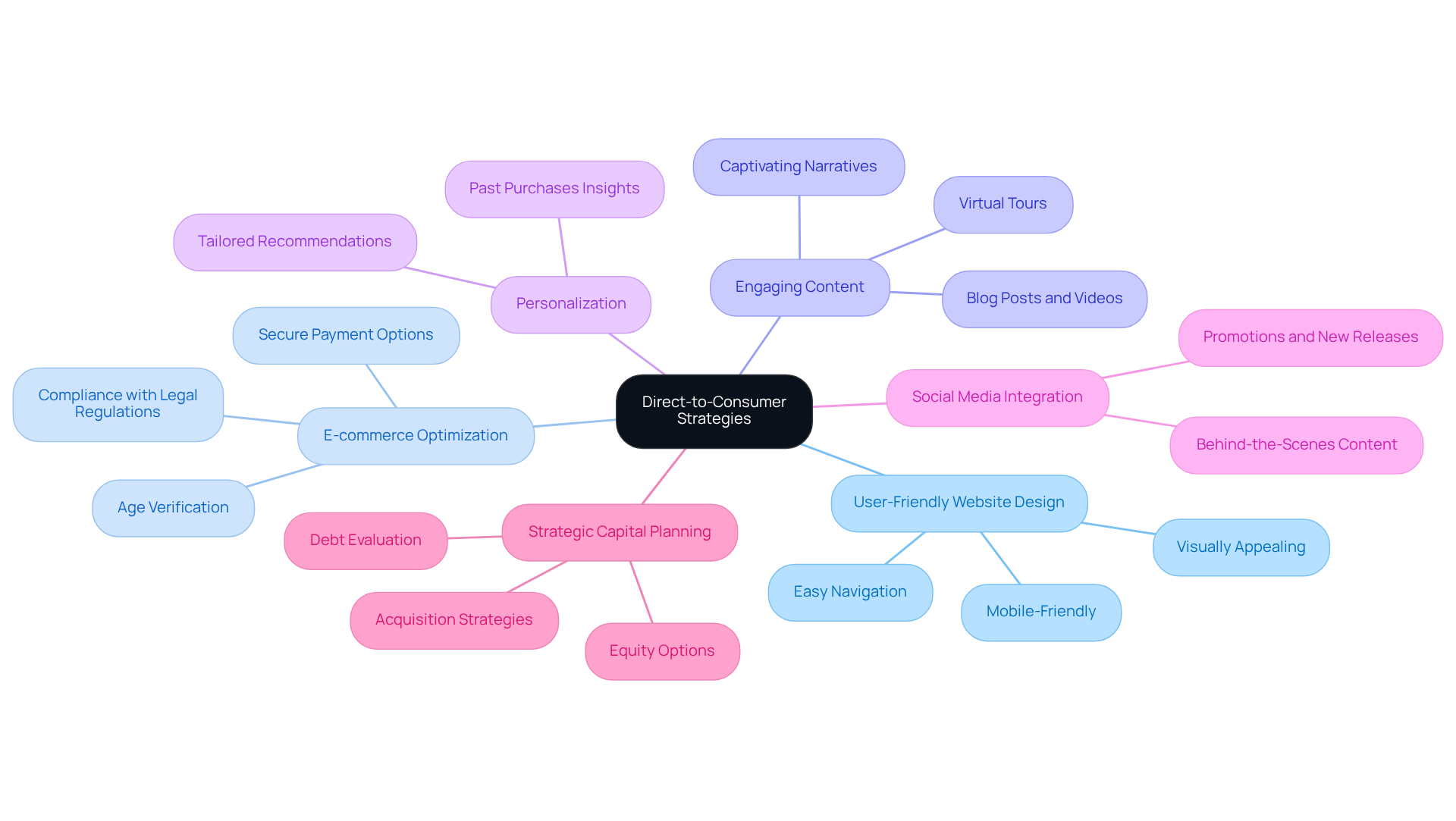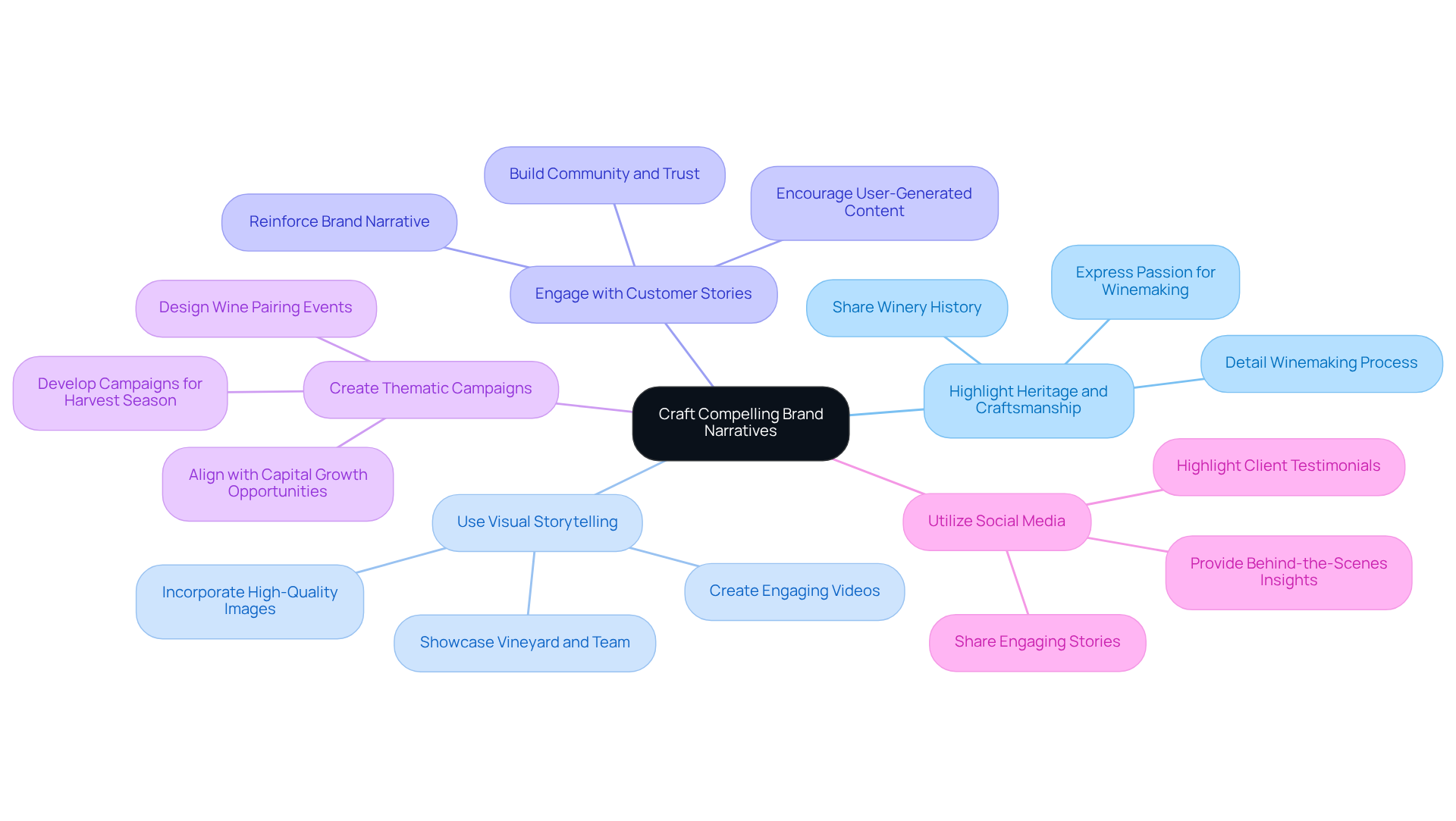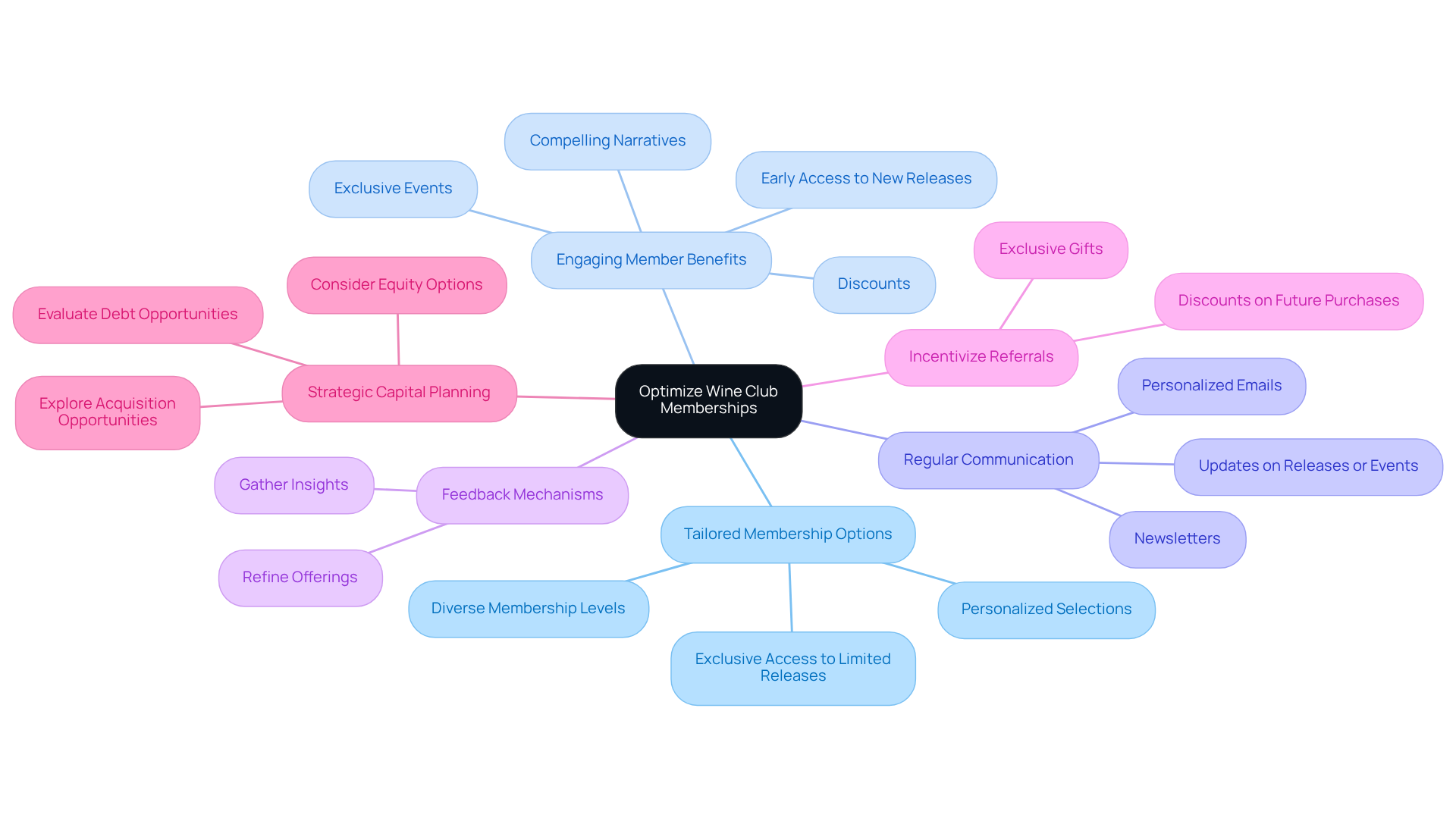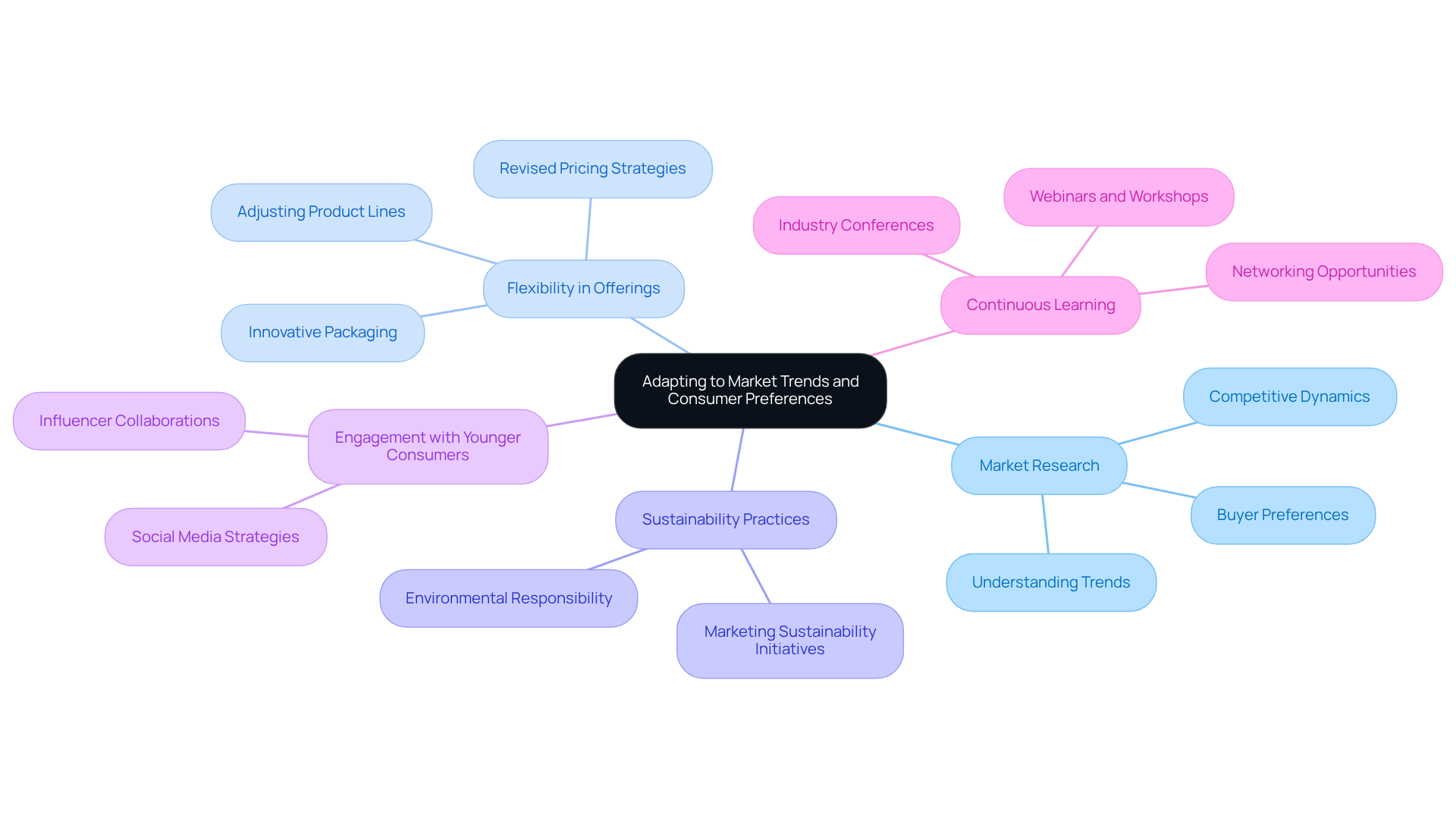Overview
This article presents proven strategies for wineries aiming to maximize sales through leading wine websites by adopting effective direct-to-consumer (DTC) approaches. It underscores the significance of:
- User-friendly designs
- E-commerce optimization
- Engaging content
- Personalization
- Social media integration
- Strategic capital planning
Collectively, these elements enhance customer experience and loyalty, ultimately driving sustainable growth for wineries. By implementing these strategies, wineries can not only attract new customers but also foster lasting relationships that contribute to their long-term success.
Introduction
The wine industry is undergoing a remarkable transformation as wineries increasingly embrace digital platforms to enhance their sales. By leveraging the capabilities of leading wine websites, these establishments can implement direct-to-consumer strategies that not only elevate their online presence but also foster a dedicated customer base.
However, as the market evolves, how can wineries adeptly navigate the complexities of consumer preferences and emerging trends to secure sustainable growth?
This article explores proven strategies that wineries can adopt to maximize their sales and effectively engage their audience.
Implement Direct-to-Consumer Strategies Using Wine Websites
To effectively implement DTC strategies through wine websites, wineries must prioritize the following key elements:
- User-Friendly Website Design: A website should be easy to navigate, visually appealing, and mobile-friendly. A well-structured site significantly enhances the shopping experience, ensuring that customers can find what they need effortlessly.
- E-commerce Optimization: It is essential to utilize e-commerce platforms that support wine sales while ensuring compliance with legal regulations. Features such as age verification and secure payment options are crucial to fostering trust and safety in transactions.
- Engaging Content: Creating captivating content that highlights the establishment's story, products, and unique offerings is vital. This can include blog posts, videos, and virtual tours that draw consumers in. By weaving engaging narratives about the vineyard, wineries can transform casual purchasers into devoted club members, thereby boosting loyalty.
- Personalization: Implementing individualized marketing strategies is key. Tailored recommendations based on past purchases or browsing behavior can significantly enhance client engagement, making customers feel valued and understood.
- Social Media Integration: Leveraging social media platforms to drive traffic to the website is imperative. Sharing promotions, new releases, and behind-the-scenes content helps create a community around the brand, fostering deeper connections with consumers.
- Strategic Capital Planning: Incorporating strategic capital planning into the business model is essential for sustainable growth. This involves evaluating options for debt, equity, or acquisition that can support the vineyard's expansion and enhance its direct-to-consumer initiatives.
By concentrating on these aspects, wine producers can effectively boost their DTC sales through top wine websites and cultivate a devoted customer base, ensuring sustainable growth for generations.

Craft Compelling Brand Narratives to Engage Consumers
To craft compelling brand narratives that resonate with consumers, wineries must leverage strategic approaches, enhanced by Enocap's expertise in direct-to-consumer growth and .
- Highlight Heritage and Craftsmanship: Begin by sharing the rich history of the winery, detailing the winemaking process, and expressing the passion that goes into each bottle. This narrative creates authenticity, a quality consumers deeply appreciate, aligning seamlessly with Enocap's focus on storytelling that drives sales.
- Use Visual Storytelling: Incorporate high-quality images and videos that vividly showcase the vineyard, the intricate winemaking process, and the dedicated individuals behind the brand. Visual content serves to evoke emotions and enhance storytelling, which is crucial for transforming casual buyers into loyal club members.
- Engage with Customer Stories: Encourage customers to share their experiences with the brand. User-generated content emerges as a powerful tool for building community and trust, thereby reinforcing the winery's narrative and fostering enduring loyalty.
- Create Thematic Campaigns: Develop marketing campaigns centered around specific themes or events that resonate with your target audience, such as harvest season or wine pairing events. These campaigns can be strategically designed to align with capital opportunities for growth.
- Utilize Social Media: Leverage social media platforms to share engaging stories and interact with customers. Consistently provide updates, behind-the-scenes insights, and client testimonials to maintain a strong connection with your audience, while also underscoring the establishment's commitment to sustainable growth through Enocap's advisory services.
By implementing these strategies, wine producers can forge compelling narratives that not only engage consumers but also cultivate brand loyalty, ultimately unlocking growth opportunities through tailored debt, equity, and acquisition solutions.

Optimize Wine Club Memberships for Customer Retention
To optimize wine club memberships for customer retention, wineries must adopt a strategic approach that encompasses several key elements:
- Tailored Membership Options: Offer a range of membership levels designed to cater to diverse preferences, including exclusive access to limited releases and personalized selections. This strategy not only elevates customer satisfaction but also aligns seamlessly with Enocap's mission to .
- Engaging Member Benefits: Deliver unique advantages for members, such as discounts, exclusive events, and early access to new releases. By weaving compelling narratives around these benefits, establishments can significantly enhance the perceived value of membership, thereby encouraging renewals and fostering lasting loyalty.
- Regular Communication: Establish consistent communication with members through newsletters, personalized emails, and updates regarding upcoming releases or events. Keeping members informed cultivates a sense of belonging and enriches the brand story—an essential factor for family-owned businesses aiming for generational success.
- Feedback Mechanisms: Implement robust feedback mechanisms to gather insights about member experiences and preferences. Leverage this information to continuously refine wine club offerings, ensuring alignment with the evolving needs of the clientele.
- Incentivize Referrals: Motivate existing members to refer friends by providing incentives such as discounts on future purchases or exclusive gifts. This approach not only facilitates natural expansion of the membership base but also strengthens the communal aspect of the establishment, enhancing overall loyalty among patrons.
- Strategic Capital Planning: Consider incorporating strategic capital planning into the wine club model. This may involve evaluating opportunities for debt, equity, or acquisition that can bolster the growth of the wine club and enrich its offerings.
By concentrating on these strategies, vineyards can significantly enhance their wine club offerings and improve customer retention, ultimately driving sustainable growth in the direct-to-consumer market.

Adapt to Market Trends and Consumer Preferences
To successfully adapt to market trends and consumer preferences, wineries must prioritize several key strategies:
- Market Research: Regularly conducting market analysis is essential to grasp emerging trends, buyer preferences, and competitive dynamics. This information forms the backbone of strategic planning.
- Flexibility in Offerings: Wineries should be prepared to adjust their product offerings based on customer feedback and market trends. This adaptability may involve introducing new varietals, innovative packaging options, or revised pricing strategies.
- Sustainability Practices: Embracing sustainability practices is increasingly important, as consumers show a preference for brands that prioritize environmental responsibility. It is vital to highlight these initiatives in marketing materials to resonate with eco-conscious customers.
- Engagement with Younger Consumers: Developing marketing strategies that connect with younger demographics is crucial. Utilizing social media and influencer collaborations can effectively broaden the audience reach.
- Continuous Learning: Staying informed about industry developments, shifts in market behavior, and technological advancements is vital. Attending industry conferences, webinars, and workshops provides valuable insights and networking opportunities.
By implementing these strategies, wineries can adeptly navigate market trends and consumer preferences, securing long-term success.

Conclusion
Maximizing sales through top wine websites necessitates a strategic approach that intricately weaves together engaging narratives, user-friendly design, and direct-to-consumer initiatives. By honing in on these critical elements, wineries can establish a formidable online presence that not only attracts new customers but also nurtures loyalty among existing ones. The integration of personalized marketing and social media engagement significantly bolsters the connection with consumers, ensuring that wineries distinguish themselves in a competitive marketplace.
Key strategies highlight the necessity of:
- A well-optimized e-commerce platform
- The art of crafting compelling brand stories
- The optimization of wine club memberships
Each of these components is vital in enhancing customer experience and retention. By customizing offerings to align with diverse consumer preferences and adapting to market trends, wineries can adeptly navigate the ever-evolving landscape of the wine industry.
Ultimately, adopting these proven strategies is imperative for wineries aspiring to flourish in the direct-to-consumer market. The emphasis on storytelling, customer engagement, and strategic planning not only propels sales but also cultivates a loyal community around the brand. Wineries are urged to implement these practices to unlock growth opportunities and secure sustainable success in the years ahead.
Frequently Asked Questions
What are the key elements for implementing Direct-to-Consumer (DTC) strategies through wine websites?
The key elements include user-friendly website design, e-commerce optimization, engaging content, personalization, social media integration, and strategic capital planning.
Why is user-friendly website design important for wineries?
A user-friendly website design is crucial because it enhances the shopping experience, making it easy for customers to navigate, find what they need, and enjoy a visually appealing interface.
What should wineries consider for e-commerce optimization?
Wineries should utilize e-commerce platforms that support wine sales and ensure compliance with legal regulations, including age verification and secure payment options to foster trust and safety in transactions.
How can engaging content benefit wineries?
Engaging content, such as blog posts, videos, and virtual tours, helps highlight the winery's story and unique offerings, transforming casual purchasers into loyal club members and boosting customer loyalty.
What role does personalization play in DTC strategies?
Personalization involves implementing individualized marketing strategies, such as tailored recommendations based on past purchases or browsing behavior, which significantly enhances client engagement and makes customers feel valued.
How can wineries use social media to support their DTC efforts?
Wineries can leverage social media platforms to drive traffic to their websites by sharing promotions, new releases, and behind-the-scenes content, which helps create a community around the brand and fosters deeper connections with consumers.
What is the significance of strategic capital planning for wineries?
Strategic capital planning is essential for sustainable growth, as it involves evaluating options for debt, equity, or acquisition that can support the vineyard's expansion and enhance its direct-to-consumer initiatives.




